
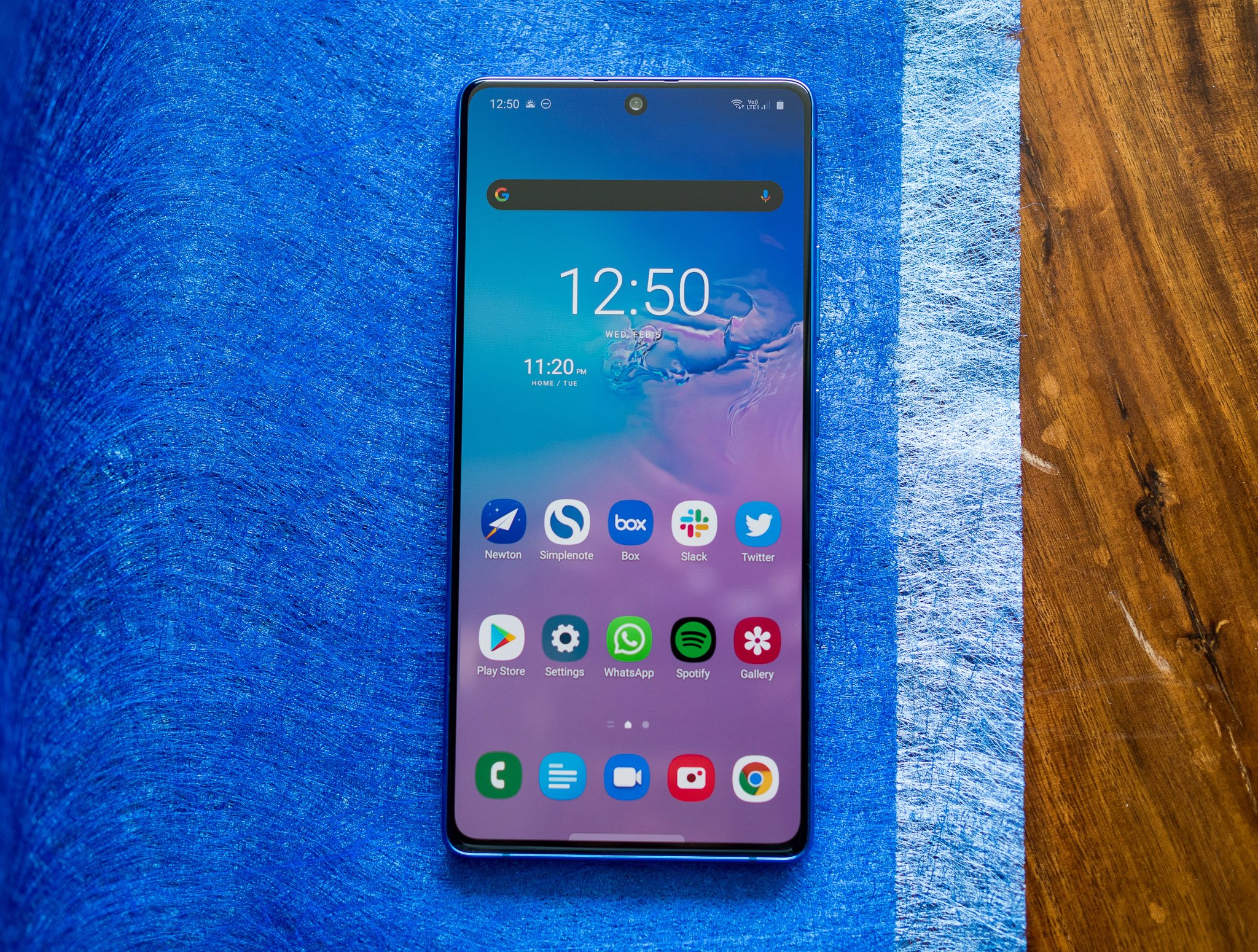 Source: Apoorva Bhardwaj / Android Central
Source: Apoorva Bhardwaj / Android Central

 Source: Apoorva Bhardwaj / Android Central
Source: Apoorva Bhardwaj / Android Central
Samsung is the dominant player in the Android world, and while its flagships continually raise the bar for the industry as a whole, the South Korean brand has failed to make a mark in the mid-range category. Samsung’s efforts in this area over the last four years were focused on the Galaxy A series, a series of mid-range devices aimed at a younger audience that offered several features from the Galaxy S series.
While there were a few noteworthy models in the Galaxy A lineup, they didn’t make a lasting impact in the mid-tier segment. Samsung’s foibles have allowed companies like OnePlus to gain momentum in this category, with the manufacturer opening up a huge lead in key markets like India.
So for 2020, Samsung is switching up its strategy. The manufacturer is getting more aggressive in the mid-range segment, and the Galaxy S10 Lite is the first salvo. The S10 Lite is an interesting device because it brings top-tier hardware and usable cameras at a much more affordable price point when seen against the likes of the Galaxy S10 or Note 10 series.
But the most interesting feature about the S10 Lite is that it comes with Qualcomm’s Snapdragon 855 chipset. That’s a huge deal for Samsung, and it immediately makes the phone that much more exciting. For the first time in over four years, Samsung has made a value flagship that you’d actually be interested in buying.
Don’t be fooled by the naming here — the S10 Lite is one of the fastest phones you’ll use in 2020.
Bottom line: The Galaxy S10 Lite is the best value flagship Samsung has released to date. The Snapdragon 855 chipset has plenty to offer in 2020, and the 4500mAh battery easily delivers over a day’s worth of use. Combine that with decent cameras and Android 10 out of the box, and you get a phone that holds its own against the OnePlus 7T.

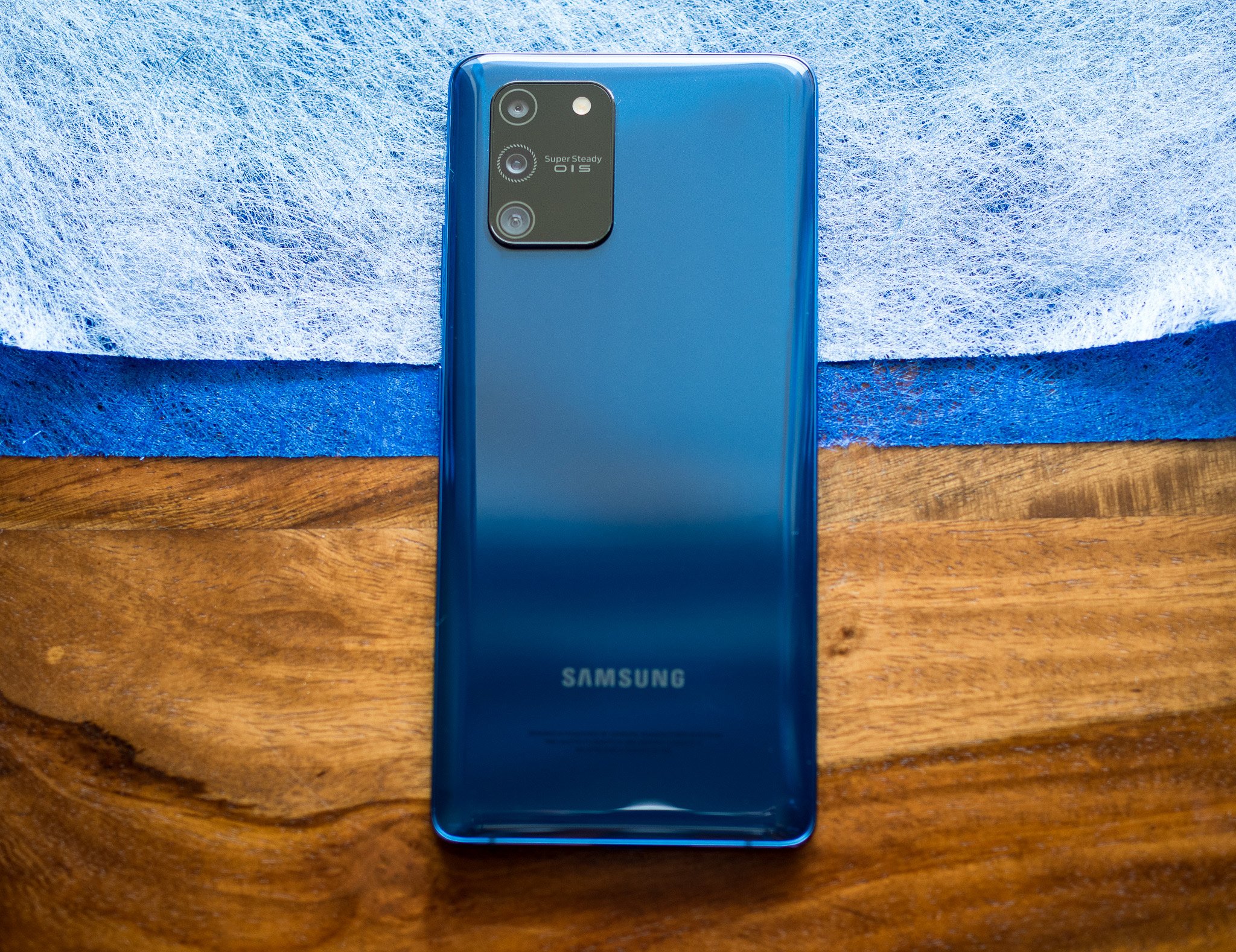 Source: Apoorva Bhardwaj / Android Central
Source: Apoorva Bhardwaj / Android Central
From the back, the Galaxy S10 Lite has more in common with the Galaxy S20 series than the S10. The rectangular camera module makes that immediately evident, and with the Infinity-O cutout at the front — just like the S20 series — the S10 Lite should have been called the S20 Lite instead.
Back to the phone itself: the S10 Lite shares the same industrial design aesthetic as recent Samsung phones, but the main difference is that there’s no glass back. Samsung instead went with a laminated polycarbonate finish that mimics the look and feel of glass.
The S10 Lite has a plastic back, but the laminated finish gives it a glass-like feel.
It’s a smart move because Samsung ends up saving on manufacturing, and you get a phone that’s lightweight and durable while still offering that same glass-like feel at the back. There’s a lot of wasted space around the rear camera housing, and the module itself protrudes slightly from the body, creating a slight wobble when the phone is laid flat on a surface. That said, you should be able to fix it with a case.
Other than that, the S10 Lite feels every bit as premium as any flagship released over the last two years. The back curves gently to meet the metal mid-frame — leading to excellent in-hand feel — and the weight distribution is perfect. The plastic design allowed Samsung to bring down weight to 186g while still offering a 4500mAh battery, and the finish prevented fingerprint smudges from showing up.
Up front, the design is dominated by the Infinity-O cutout, similar to what we’ve seen on the Galaxy Note 10 series. Samsung has tested several camera cutouts over the last 12 months, and it looks like a centered camera is the brand’s go-to choice for 2020. I prefer this to what we got on the S10 last year, as the cutout no longer pushes status icons to the left.
Rounding out the design, you get power and volume buttons on the right, and they’re just as tactile as the ones on the S10 or Note 10. There’s a single speaker tucked away at the bottom next to the USB-C port, and the dual-SIM card tray is located on the right side. The hybrid tray lets you slot in two SIM cards or a nano SIM with a microSD card.
The tall 6.7-inch display isn’t ideal for one-handed use, but the panel itself is fantastic.
There’s no 3.5mm jack on the S10 Lite; Samsung got rid of the analog jack on the Note 10 series, and that trend has continued with the S20 series and S10 Lite. Curiously enough, the Note 10 Lite is the only premium Samsung phone in 2020 to feature the jack.
Interestingly, the S10 Lite offers the largest display of any phone in the S10 series, with the 6.7-inch display easily edging out the 6.4-inch panel on the S10+. It is also 4.9mm taller than the S10+ and is, in fact, taller than the 6.8-inch screen-toting Note 10+. The tall dimensions make it all but impossible to use the S10 Lite one-handed, but the panel quality more than makes up for the sheer size of the phone.
The S10 Lite features a 20:9 Super AMOLED+ panel, and it is one of the best displays you’ll find for under $600. The resolution itself is at 2400 x 1080, but you get excellent color vibrancy and contrast levels. Sunlight visibility is also excellent, and the fact that there’s HDR10+ makes watching videos on Netflix and YouTube that much more enticing.

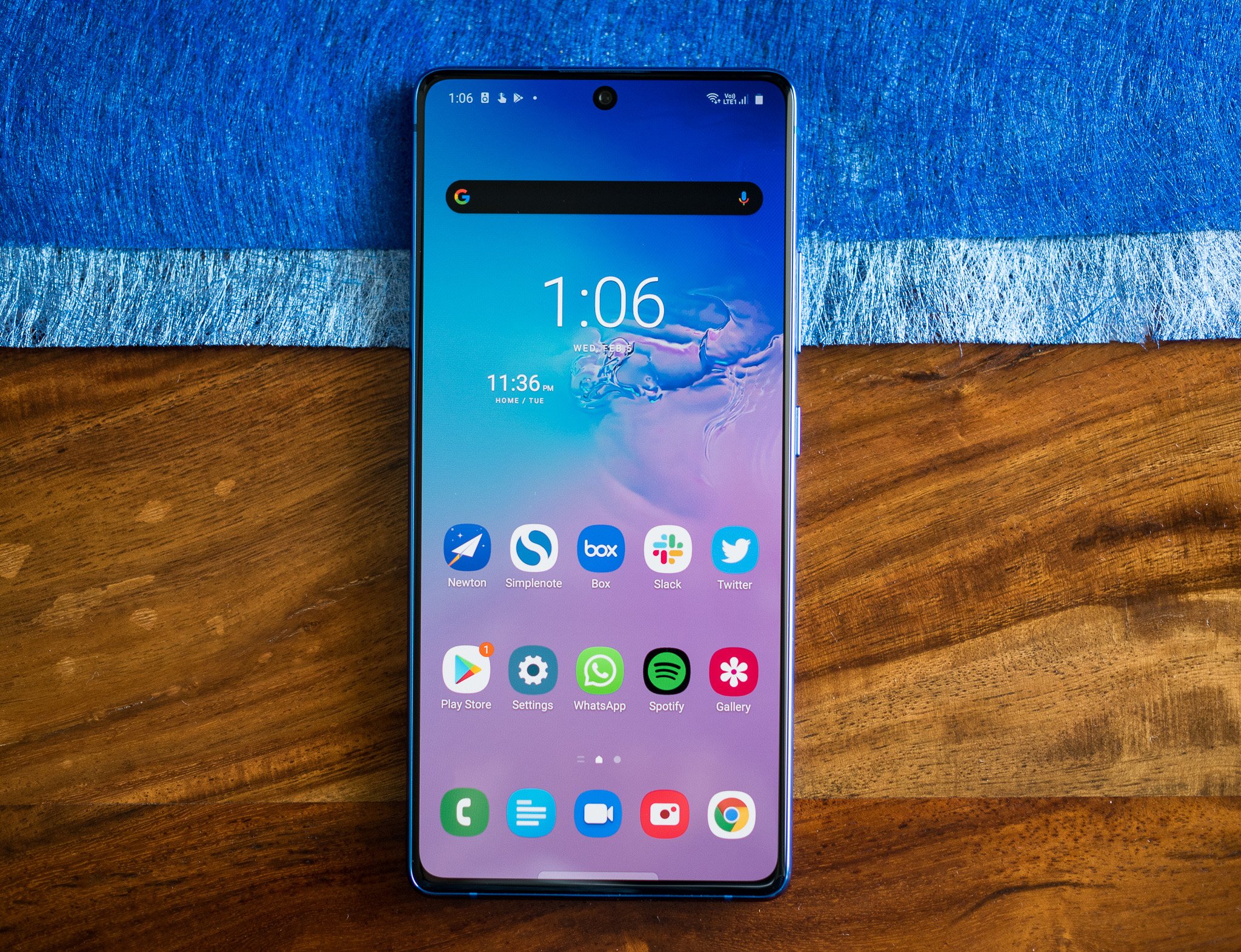 Source: Apoorva Bhardwaj / Android Central
Source: Apoorva Bhardwaj / Android Central
There are several interesting points when it comes to the hardware on the S10 Lite. First up is the fact that it is powered by Qualcomm’s 7nm Snapdragon 855 chipset. That is a big deal because Samsung has always used its in-house Exynos chipsets in its mid-range phones. There have been a few Galaxy A devices over the years that featured Snapdragon chipsets, but for Samsung to offer the flagship Snapdragon 855 in a phone that costs $600 is a fundamental rethinking of its strategy.
| Specs | Samsung Galaxy S10 Lite |
|---|---|
| Software | One UI 2.0 based on Android 10 |
| Display | 6.7-inch (2400×1080) Super AMOLED |
| Chipset | 2.84GHz Snapdragon 855 |
| RAM | 6GB/8GB |
| Storage | 128GB |
| Rear Camera 1 | 48MP ƒ/2.0 (primary) |
| Rear Camera 2 | 12MP ƒ/2.2 (wide-angle) |
| Rear Camera 3 | 5MP ƒ/2.4 (macro) |
| Front Camera 1 | 32MP ƒ/2.2 |
| Connectivity | Wi-Fi 802.11 ac, BT5.0, NFC |
| Battery | 4500mAh | 25W |
| Security | In-screen fingerprint |
| Colors | Prism White, Prism Black, Prism Blue |
| Dimensions | 162.5 x 75.6 x 8.1mm |
| Weight | 186g |
Samsung also outfitted the S10 Lite with a massive 4500mAh battery, but what’s even more interesting is that there’s 25W fast charging. You get a 25W charger in the box, and it gives the phone a definite leg up over the rest of the S10 series. As I mentioned before, Samsung is doing this phone a disservice by branding it under the S10 series.
The massive battery allows the S10 Lite to deliver stellar usage figures, and I routinely got over a day’s worth of use between charges. Even with heavy use that included over seven hours of screen-on-time, the battery never fell under 15% by the end of the day. Samsung’s recent phones have struggled with battery life — particularly in global markets — so it is great to be able to use a phone that delivers excellent figures in this area. When you need to top up, the bundled 25W charger delivers up to a 60% charge in just over 30 minutes.
The Snapdragon 855 chipset immediately turns the S10 Lite into a performance beast. Samsung’s Galaxy A devices have always struggled with performance, but that is not a problem on the S10 Lite. You won’t notice any slowdowns whatsoever, and the Snapdragon 855 has zero issues in day-to-day use.
There’s also 128GB of internal storage as standard, and you can pick up the S10 Lite with either 6 or 8GB of RAM. You also get a Wi-Fi ac modem, Bluetooth 5.0, NFC with Samsung Pay, and an in-screen fingerprint reader that works reliably. You’re missing water resistance and wireless charging here, but that was always going to be the case. Had Samsung included those two features as well, there would be no reason to pick up the standard S10 series over the S10 Lite.
Another interesting point to note is that this is the first time Samsung is offering a high-end Snapdragon chipset in global markets. Barring the U.S. and China, Samsung uses Exynos chipsets exclusively on its phones, so it is a nice change to be able to use Qualcomm hardware on a Samsung phone. In fact, the S10 Lite is the Samsung phone I’ve used that had a high-end Snapdragon chipset, and it was a thoroughly enjoyable experience. The latest Exynos designs aren’t slow by any measure, but they’re not on the same level as Qualcomm when it comes to energy efficiency.

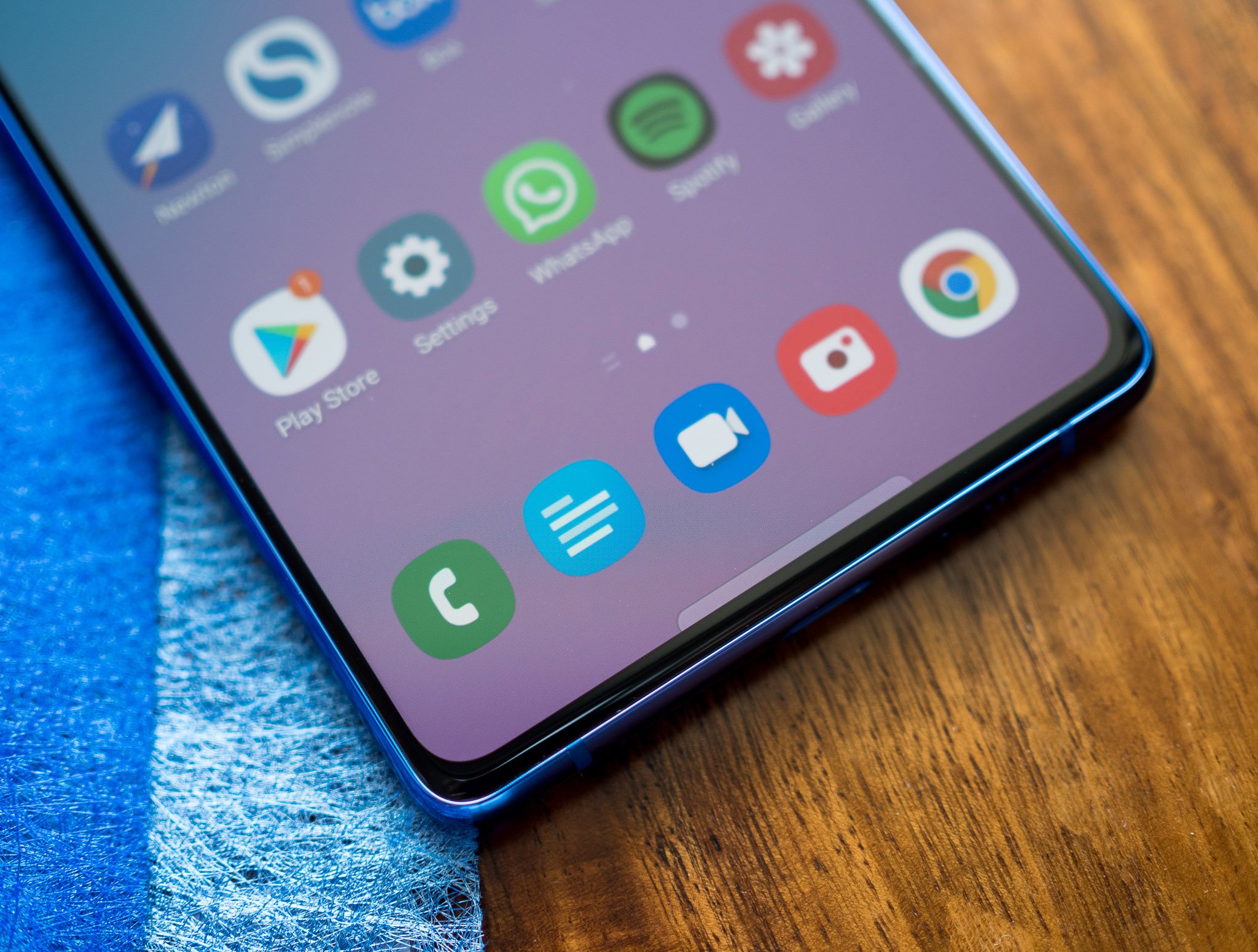 Source: Apoorva Bhardwaj / Android Central
Source: Apoorva Bhardwaj / Android Central
Another area where Samsung has made considerable changes from previous mid-range offerings is the software. The S10 Lite comes with One UI 2.0 based on Android 10 out of the box, and the phone will receive timely updates.
The Snapdragon 855 chipset makes One UI 2.0 absolutely shine in day-to-day use.
While there isn’t a lot of visual redesign from One UI 1.5, Samsung has integrated all the new features in Android 10 into its skin. The most significant change is that the system-wide dark theme works on third-party apps like Chrome and Instagram as well. Features that have been a mainstay on Samsung phones for several generations — like always-on display and Samsung Pay — are back, and you get an exhaustive amount of customizability.
Samsung also offers Android 10’s default gesture navigation as an alternative to the brand’s own gestures, so you have the freedom to pick the navigation style you’re most comfortable with. For a full list of all the new features in One UI 2.0, head to our detailed review.
Samsung has done a decent job cutting down on overt customization in the last two years, and the result is that One UI 2.0 feels modern and polished. There was absolutely no lag anywhere thanks to the Snapdragon 855, and while you’ll still find a few annoyances — like Bixby — Samsung has done a great job cleaning up its interface.

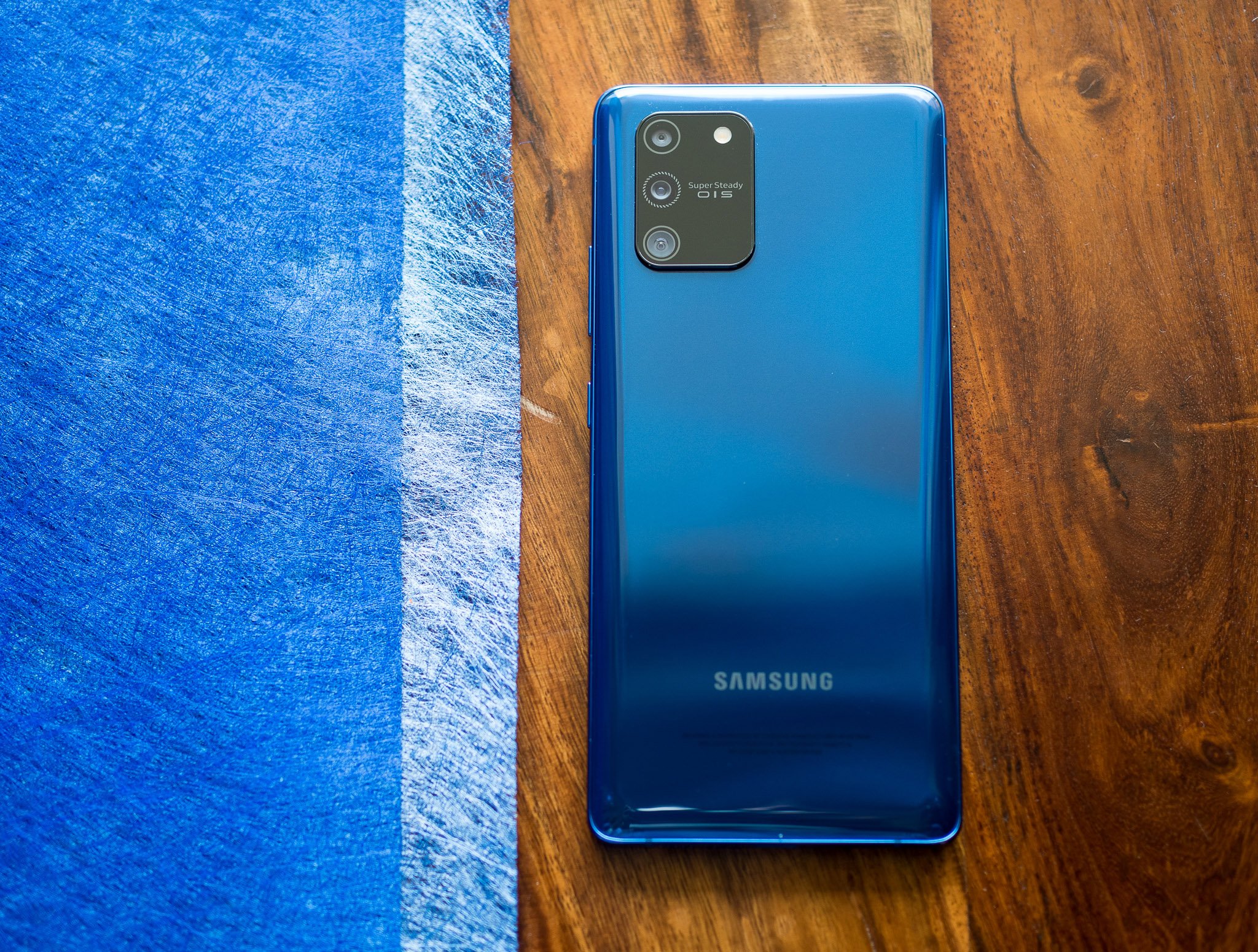 Source: Apoorva Bhardwaj / Android Central
Source: Apoorva Bhardwaj / Android Central
Samsung is touting the camera features on the S10 Lite as a primary differentiator and for a good reason. The phone has a 48MP f/2.0 lens backed by a 12MP wide-angle shooter and a 5MP macro lens, and you get a 32MP camera at the front.
The glaring omission is a zoom lens, with Samsung instead choosing to outfit the S10 Lite with a macro lens instead. This isn’t a new trend, with several Chinese manufacturers going the same route in recent months. To Samsung’s credit, the 5MP shooter is of a higher resolution than what we’ve seen from the likes of Xiaomi and Realme, and in real-world use, the macro lens fared very well.
The camera interface itself has a new design with a cleaner ribbon layout and new toggle icons, but not all shooting modes show up on the bottom bar by default. The macro mode is hidden behind the More menu, so you’ll have to go through a few extra steps to launch the macro lens. You can change this by adding modes you frequently use to the ribbon layout.
You get the option to take motion photos, with the phone recording a few seconds of video just before you press the shutter button. There’s also auto HDR and a host of beautifying effects and filters, and Samsung’s scene optimizer is included here as well. You also get Live focus for both photos and videos, and there’s a toggle that easily lets you switch between the primary and wide-angle lenses.
The S10 Lite takes photos with vibrant and saturated colors, and there’s decent dynamic range here. You get the same caliber of shots from the wide-angle lens as well, and that’s particularly true of images taken in low-light conditions. The primary 48MP lens manages to take great shots in low-light scenarios, with plenty of detail and low noise.

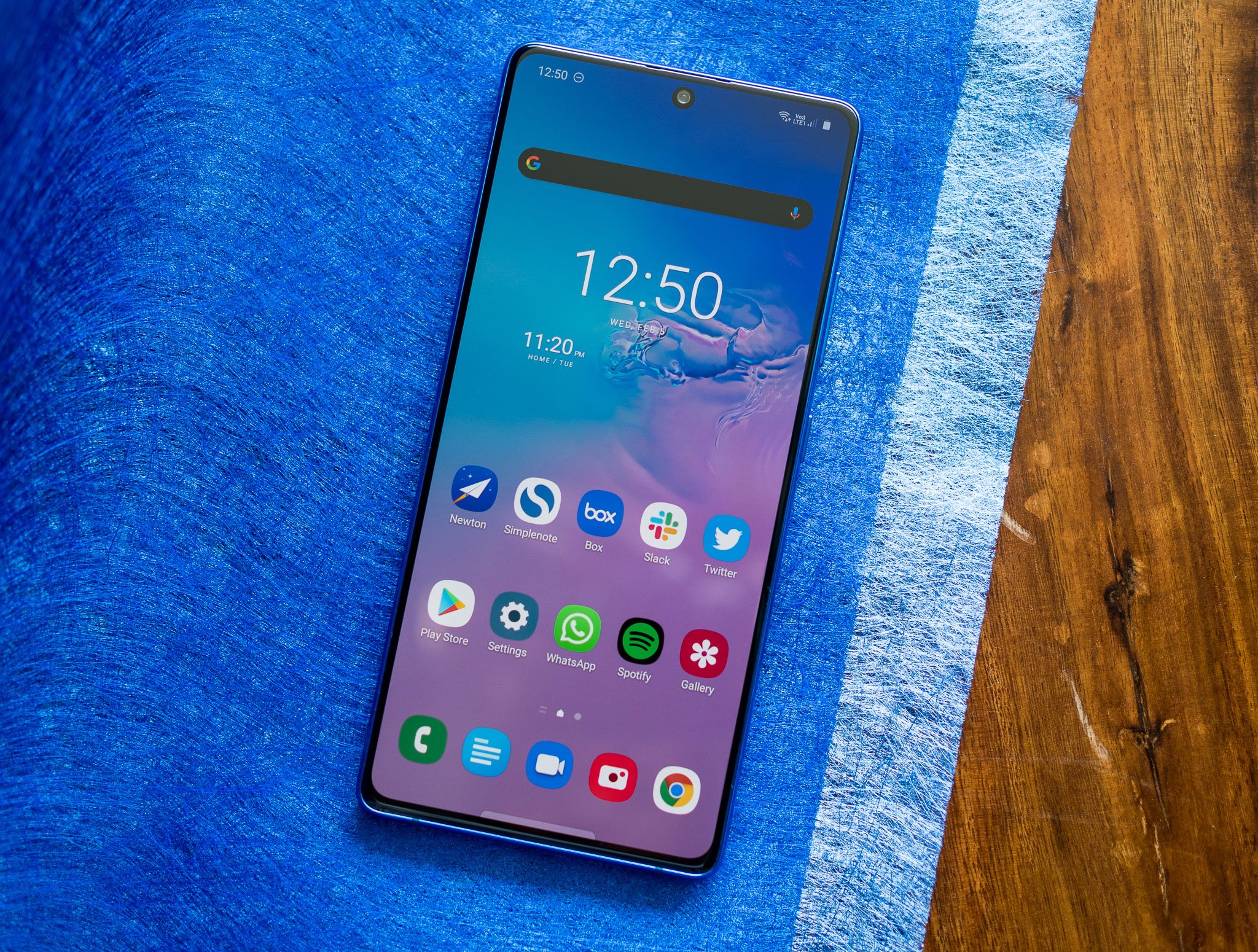 Source: Apoorva Bhardwaj / Android Central
Source: Apoorva Bhardwaj / Android Central
With the S10 Lite, Samsung has finally shown that it can deliver a value flagship that can take on the likes of OnePlus, Xiaomi, and others. The phone absolutely nails the basics, and by going with a Snapdragon 855 chipset instead of an Exynos design, Samsung has ensured that the phone isn’t hobbled in terms of performance.
Then there’s the fact that you’re getting a massive 4500mAh battery with 25W fast charging, making the phone just that much more exciting. The large 6.7-inch AMOLED panel is also one of the best you’ll find in this category, and you get 6GB of RAM with 128GB of storage and a MicroSD card slot. The cameras are also great in their own right, and you get Android 10 out of the box.
The Galaxy S10 Lite is on sale in the U.K. and other global markets, but it is in India where the phone is particularly interesting. Samsung is selling the S10 Lite for ₹39,999 in India, and that comes out to $560. To put things into context, the same phone costs £579 in the U.K., or $755. That’s nearly a $200 difference between the two markets, and it goes to show just how aggressive brands have to be in India to gain market share.
Overall, the S10 Lite is the best value-driven flagship Samsung has launched to date. There really isn’t anything missing here, and when you consider how much the S10 Lite costs, it is a fantastic deal.
The S10 Lite is directly going up against the likes of the OnePlus 7T. OnePlus’ offering has a 90Hz display and cleaner software, and it is available for ₹34,999 ($490) in India. Sure, you’re missing out on the 90Hz refresh rate, but the screen on the S10 Lite is incredible in its own right, and you’re getting much better cameras and significantly better battery life here.
Samsung’s best value flagship to date.
The Galaxy S10 Lite is the best value flagship Samsung has released to date. The Snapdragon 855 chipset has plenty to offer in 2020, and the 4500mAh battery easily delivers over a day’s worth of use. Combine that with decent cameras and Android 10 out of the box, and you get a phone that holds its own against the OnePlus 7T.
We may earn a commission for purchases using our links. Learn more.

Although no one likes a know-it-all, they dominate the Internet.
The Internet began as a vast repository of information. It quickly became a breeding ground for self-proclaimed experts seeking what most people desire: recognition and money.
Today, anyone with an Internet connection and some typing skills can position themselves, regardless of their education or experience, as a subject matter expert (SME). From relationship advice, career coaching, and health and nutrition tips to citizen journalists practicing pseudo-journalism, the Internet is awash with individuals—Internet talking heads—sharing their “insights,” which are, in large part, essentially educated guesses without the education or experience.
The Internet has become a 24/7/365 sitcom where armchair experts think they’re the star.
Not long ago, years, sometimes decades, of dedicated work and acquiring education in one’s field was once required to be recognized as an expert. The knowledge and opinions of doctors, scientists, historians, et al. were respected due to their education and experience. Today, a social media account and a knack for hyperbole are all it takes to present oneself as an “expert” to achieve Internet fame that can be monetized.
On the Internet, nearly every piece of content is self-serving in some way.
The line between actual expertise and self-professed knowledge has become blurry as an out-of-focus selfie. Inadvertently, social media platforms have created an informal degree program where likes and shares are equivalent to degrees. After reading selective articles, they’ve found via and watching some TikTok videos, a person can post a video claiming they’re an herbal medicine expert. Their new “knowledge,” which their followers will absorb, claims that Panda dung tea—one of the most expensive teas in the world and isn’t what its name implies—cures everything from hypertension to existential crisis. Meanwhile, registered dietitians are shaking their heads, wondering how to compete against all the misinformation their clients are exposed to.
More disturbing are individuals obsessed with evangelizing their beliefs or conspiracy theories. These people write in-depth blog posts, such as Elvis Is Alive and the Moon Landings Were Staged, with links to obscure YouTube videos, websites, social media accounts, and blogs. Regardless of your beliefs, someone or a group on the Internet shares them, thus confirming your beliefs.
Misinformation is the Internet’s currency used to get likes, shares, and engagement; thus, it often spreads like a cosmic joke. Consider the prevalence of clickbait headlines:
Titles that make outrageous claims are how the content creator gets reads and views, which generates revenue via affiliate marketing, product placement, and pay-per-click (PPC) ads. Clickbait headlines are how you end up watching a TikTok video by a purported nutrition expert adamantly asserting you can lose belly fat while you sleep by drinking, for 14 consecutive days, a concoction of raw eggs, cinnamon, and apple cider vinegar 15 minutes before going to bed.
Our constant search for answers that’ll explain our convoluted world and our desire for shortcuts to success is how Internet talking heads achieve influencer status. Because we tend to seek low-hanging fruits, we listen to those with little experience or knowledge of the topics they discuss yet are astute enough to know what most people want to hear.
There’s a trend, more disturbing than spreading misinformation, that needs to be called out: individuals who’ve never achieved significant wealth or traded stocks giving how-to-make-easy-money advice, the appeal of which is undeniable. Several people I know have lost substantial money by following the “advice” of Internet talking heads.
Anyone on social media claiming to have a foolproof money-making strategy is lying. They wouldn’t be peddling their money-making strategy if they could make easy money.
Successful people tend to be secretive.
Social media companies design their respective algorithms to serve their advertisers—their source of revenue—interest; hence, content from Internet talking heads appears most prominent in your feeds. When a video of a self-professed expert goes viral, likely because it pressed an emotional button, the more people see it, the more engagement it receives, such as likes, shares and comments, creating a cycle akin to a tornado.
Imagine scrolling through your TikTok feed and stumbling upon a “scientist” who claims they can predict the weather using only aluminum foil, copper wire, sea salt and baking soda. You chuckle, but you notice his video got over 7,000 likes, has been shared over 600 times and received over 400 comments. You think to yourself, “Maybe this guy is onto something.” What started as a quest to achieve Internet fame evolved into an Internet-wide belief that weather forecasting can be as easy as DIY crafts.
Since anyone can call themselves “an expert,” you must cultivate critical thinking skills to distinguish genuine expertise from self-professed experts’ self-promoting nonsense. While the absurdity of the Internet can be entertaining, misinformation has serious consequences. The next time you read a headline that sounds too good to be true, it’s probably an Internet talking head making an educated guess; without the education seeking Internet fame, they can monetize.
______________________________________________________________
Nick Kossovan, a self-described connoisseur of human psychology, writes about what’s
on his mind from Toronto. You can follow Nick on Twitter and Instagram @NKossovan.

TORONTO – A new survey says a majority of software engineers and developers feel tight project deadlines can put safety at risk.
Seventy-five per cent of the 1,000 global workers who responded to the survey released Tuesday say pressure to deliver projects on time and on budget could be compromising critical aspects like safety.
The concern is even higher among engineers and developers in North America, with 77 per cent of those surveyed on the continent reporting the urgency of projects could be straining safety.
The study was conducted between July and September by research agency Coleman Parkes and commissioned by BlackBerry Ltd.’s QNX division, which builds connected-car technology.
The results reflect a timeless tug of war engineers and developers grapple with as they balance the need to meet project deadlines with regulations and safety checks that can slow down the process.
Finding that balance is an issue that developers of even the simplest appliances face because of advancements in technology, said John Wall, a senior vice-president at BlackBerry and head of QNX.
“The software is getting more complicated and there is more software whether it’s in a vehicle, robotics, a toaster, you name it… so being able to patch vulnerabilities, to prevent bad actors from doing malicious acts is becoming more and more important,” he said.
The medical, industrial and automotive industries have standardized safety measures and anything they produce undergoes rigorous testing, but that work doesn’t happen overnight. It has to be carried out from the start and then at every step of the development process.
“What makes safety and security difficult is it’s an ongoing thing,” Wall said. “It’s not something where you’ve done it, and you are finished.”
The Waterloo, Ont.-based business found 90 per cent of its survey respondents reported that organizations are prioritizing safety.
However, when asked about why safety may not be a priority for their organization, 46 per cent of those surveyed answered cost pressures and 35 per cent said a lack of resources.
That doesn’t surprise Wall. Delays have become rampant in the development of tech, and in some cases, stand to push back the launch of vehicle lines by two years, he said.
“We have to make sure that people don’t compromise on safety and security to be able to get products out quicker,” he said.
“What we don’t want to see is people cutting corners and creating unsafe situations.”
The survey also took a peek at security breaches, which have hit major companies like London Drugs, Indigo Books & Music, Giant Tiger and Ticketmaster in recent years.
About 40 per cent of the survey’s respondents said they have encountered a security breach in their employer’s operating system. Those breaches resulted in major impacts for 27 per cent of respondents, moderate impacts for 42 per cent and minor impacts for 27 per cent.
“There are vulnerabilities all the time and this is what makes the job very difficult because when you ship the software, presumably the software has no security vulnerabilities, but things get discovered after the fact,” Wall said.
Security issues, he added, have really come to the forefront of the problems developers face, so “really without security, you have no safety.”
This report by The Canadian Press was first published Oct. 8, 2024.
Companies in this story: (TSX:BB)
The Canadian Press. All rights reserved.

As online shoppers hunt for bargains offered by Amazon during its annual fall sale this week, cybersecurity researchers are warning Canadians to beware of an influx of scammers posing as the tech giant.
In the 30 days leading up to Amazon’s Prime Big Deal Days, taking place Tuesday and Wednesday, there were more than 1,000 newly registered Amazon-related web domains, according to Check Point Software Technologies, a company that offers cybersecurity solutions.
The company said it deemed 88 per cent of those domains malicious or suspicious, suggesting they could have been set up by scammers to prey on vulnerable consumers. One in every 54 newly created Amazon-related domain included the phrase “Amazon Prime.”
“They’re almost indiscernible from the real Amazon domain,” said Robert Falzon, head of engineering at Check Point in Canada.
“With all these domains registered that look so similar, it’s tricking a lot of people. And that’s the whole intent here.”
Falzon said Check Point Research sees an uptick in attempted scams around big online shopping days throughout the year, including Prime Days.
Scams often come in the form of phishing emails, which are deceptive messages that appear to be from a reputable source in attempt to steal sensitive information.
In this case, he said scammers posing as Amazon commonly offer “outrageous” deals that appear to be associated with Prime Days, in order to trick recipients into clicking on a malicious link.
The cybersecurity firm said it has identified and blocked 100 unique Amazon Prime-themed scam emails targeting organizations and consumers over the past two weeks.
Scammers also target Prime members with unsolicited calls, claiming urgent account issues and requesting payment information.
“It’s like Christmas for them,” said Falzon.
“People expect there to be significant savings on Prime Day, so they’re not shocked that they see something of significant value. Usually, the old adage applies: If it seems too good to be true, it probably is.”
Amazon’s website lists a number of red flags that it recommends customers watch for to identify a potential impersonation scam.
Those include false urgency, requests for personal information, or indications that the sender prefers to complete the purchase outside of the Amazon website or mobile app.
Scammers may also request that customers exclusively pay with gift cards, a claim code or PIN. Any notifications about an order or delivery for an unexpected item should also raise alarm bells, the company says.
“During busy shopping moments, we tend to see a rise in impersonation scams reported by customers,” said Amazon spokeswoman Octavia Roufogalis in a statement.
“We will continue to invest in protecting consumers and educating the public on scam avoidance. We encourage consumers to report suspected scams to us so that we can protect their accounts and refer bad actors to law enforcement to help keep consumers safe.”
Falzon added that these scams are more successful than people might think.
As of June 30, the Canadian Anti-Fraud Centre said there had been $284 million lost to fraud so far this year, affecting 15,941 victims.
But Falzon said many incidents go unreported, as some Canadians who are targeted do not know how or where to flag a scam, or may choose not to out of embarrassment.
Check Point recommends Amazon customers take precautions while shopping on Prime Days, including by checking URLs carefully, creating strong passwords on their accounts, and avoiding personal information being shared such as their birthday or social security number.
The cybersecurity company said consumers should also look for “https” at the beginning of a website URL, which indicates a secure connection, and use credit cards rather than debit cards for online shopping, which offer better protection and less liability if stolen.
This report by The Canadian Press was first published Oct. 8, 2024.


Defying Convention to Deepen Connections: Booking.com’s 8 Travel Predictions for 2025


After hurricane, with no running water, residents organize to meet a basic need


In The Rings: Curling Canada still looking for Canadian Curling Trials title sponsor


N.B. election debate: Tory leader forced to defend record on gender policy, housing


Alberta government shifts continuing care from Health to Seniors Ministry


Buhai, Green and Shin lead in South Korea after 8-under 64s in first round


Manitoba government halts school building plan, says other methods will be found


‘Significant overreach’: Ontario municipalities slam province over bike lane rules